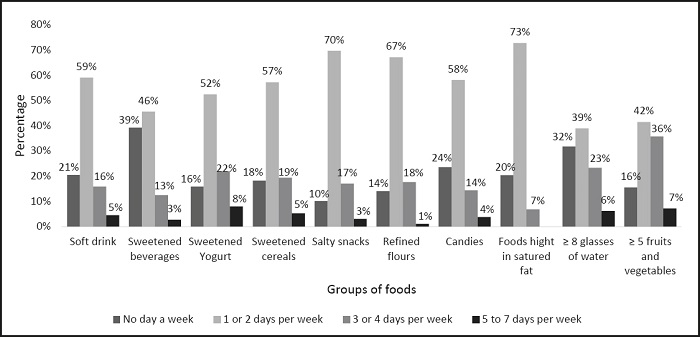Dear Editor,
Due to the recent publication of “Estado nutricional y niveles de ansiedad durante la pandemia de COVID-19” (1) and “Conducta alimentaria y su relación con el estrés, la ansiedad, la depresión y el insomnio en estudiantes universitarios” (2), where the authors have reported higher probabilities of anxiety due to the consumption of sugary drinks, fast food and pastries, we would like to complement this information approaching another study population. The main effects of confinement have been shown because of reduced mobility, generating greater physical inactivity and mostly sedentary behavior (3,4); at the same time, changes in eating habits occurred, as evidence suggests fewer proper diets during confinement, as well as an increase in screen time, a situation that may lead to irregular sleep problems, leading to mental health issues that generated anxiety and depression alerts, and effects on the overall health of children (5). That is why we analyze the changes in physical activity (PA) during confinement for COVID-19 and their relationship with eating habits and anxiety in schoolchildren aged 8 to 12 years.
The tutors of 278 children answered questions about PA, anxiety, frequency of feeding, and data such as sleep and screen time. The results show an inverse correlation was found between screen time and minutes of PA during confinement (r = -0.175, p < 0.001) and changes in the time of PA before-during confinement (r = -0.181, p = 0.003). It did present an inverse correlation with screen time (r = -0.168, p = 0.006). The frequency of food consumption was not related to PA levels or PA time as carried out before and during confinement (p > 0.05); those who consumed soft drinks from 3-4 and 5-7 days a week (x̃= 240 min, IQR = 180 min; = 300 min, IQR = 270 min, respectively), who consumed salty snacks from 3-4 and 5-7 days a week (x̃= 240 min, IQR = 180 min; = 270 min, IQR = 270 min, respectively), who consumed candies from 5-7 days a week (x̃= 480 min, IQR = 225 min), and who consumed foods rich in saturated fat 1-2 days a week (x̃= 180 min, IQR = 120 min) had more screen time compared to those who usually do not report consuming any of these foods per week (x̃= 180 min, IQR = 150 min for soft drinks; = 180 min, IQR = 195 min for salty snacks; = 180 min, IQR = 210 min for candies; = 180 min, IQR = 148 min for foods rich in saturated fat [p < 0.05]).
Concerning anxiety, those who consumed refined flours 5-7 days a week (x̃= 7, IQR = 1) had a higher anxiety score (p < 0.05) than those who consumed 1-2 times a week (x̃= 2, IQR = 5) and those who did not consume them any day of the week (x̃= 3, IQR = 4); in addition, those who consumed salty snacks 5-7 times a week (x̃= 6, IQR = 5) compared to those who consumed them 1-2 times a week (x̃= 2, IQR = 4) and those who reported not consuming them at all per week (x̃= 2, IQR = 2). A considerable decrease in PA levels and an increase in sedentary lifestyle were found in schoolchildren aged 8 to 12, mainly in those schoolchildren who feel that someone will tell them that they are doing everything wrong. Likewise, a relationship was observed of screen time with anxiety and unhealthy eating.















